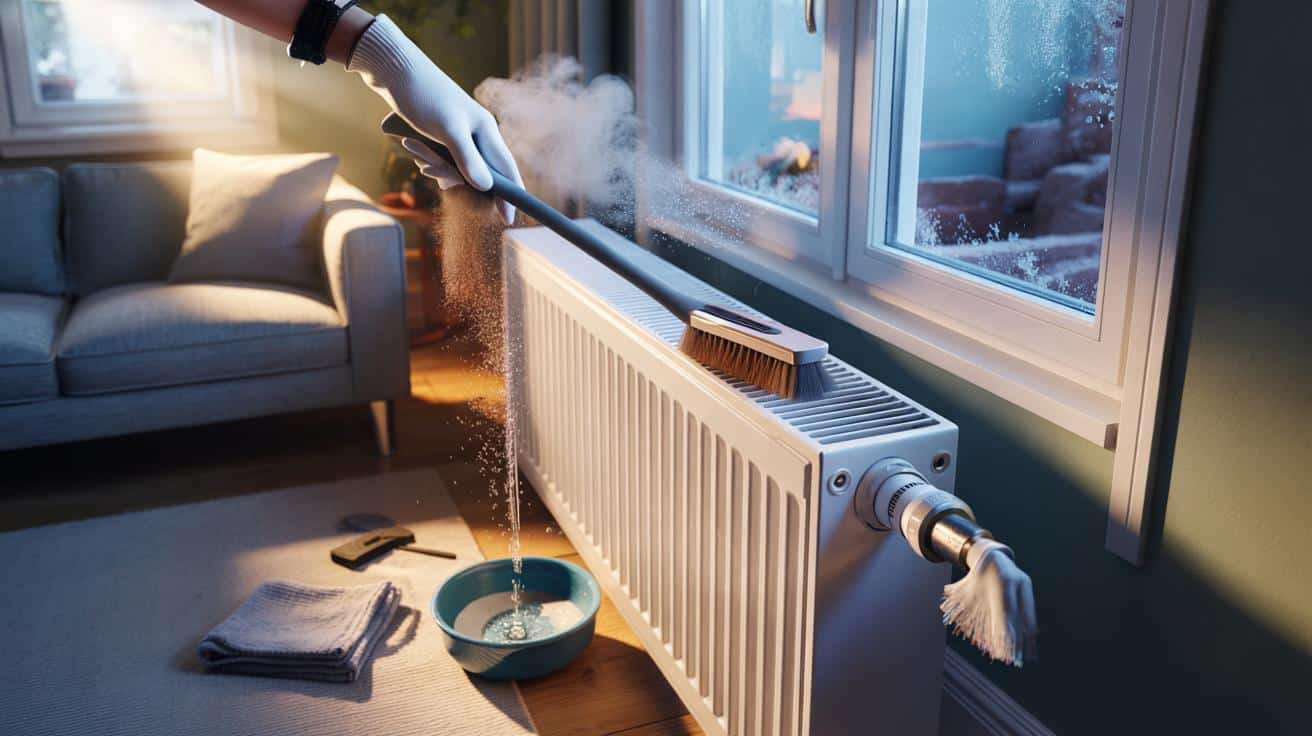As nights snap colder and thermostats creep up, a small job with a brush, a bowl and a radiator key can pay off fast. You gain steadier warmth, fresher air and lower bills, without touching your boiler settings.
Why a dirty radiator costs you
Radiators move heat by pushing air across hot metal. Dust and fibres cling to fins and grills, forming a fuzzy coat that slows that flow. Hot-water systems can trap air too, which blocks circulation and leaves sections tepid. The result is uneven rooms, longer warm-up, and a boiler or heater working harder for the same comfort.
Meter logs and household trials point to realistic savings of 5–10% after a proper clean and a quick bleed of hot‑water units. One Leeds renter in a 1930s terrace noted the end of gurgling, stable temperatures across rooms and roughly 8% lower spend over two months, with settings unchanged. The mechanism is simple physics, not gadgetry.
Dust insulates like an overcoat. Air pockets act like corks in your hot‑water circuit. Clear both, and heat moves freely.
Electric convectors and panel heaters bring another nuisance. When deposits sit on elements, they scorch, releasing that burnt‑dust odour and small particles that irritate throats and noses. A careful vacuum and wipe reduces the smell and the spike in particulates when you first switch on.
How to do it safely in 15 minutes
Gas and hot‑water systems
Electric convectors and panel heaters
Skip sprays and oily polishes on grills. Residue bakes onto elements, cooking into acrid fumes next time you heat.
What you might save this winter
Cleaning and bleeding do not change your tariff, but they reduce waste. If your heating spend sits around common figures, here is what a 5–10% improvement looks like.
| Annual heating spend | 5% saving | 10% saving |
|---|---|---|
| £800 | £40 | £80 |
| £1,200 | £60 | £120 |
| £1,380 | £69 | £138 |
| £1,800 | £90 | £180 |
You’ll also notice gains that do not show up on a bill. Rooms warm evenly. The thermostat stops overshooting. Radiators stop clicking and gurgling as air clears and metal expands more smoothly.
Tools that make the job easy
- Vacuum with soft brush attachment
- Long radiator brush or slim duster
- Two microfibres and a small bowl
- Radiator bleed key and a light glove
- Dry cloth for thermostatic valve heads
Set a calendar reminder for one thorough clean before first full‑time heating and a light midwinter refresh. Fifteen minutes per unit transforms the feel of the house.
Air quality and your lungs
Heating stirs up what settled all summer: skin flakes, textile fibres and fine dust. Electric heaters can singe those deposits. Hot‑water systems lift particles as air flows across fins. Many people report scratchy throats or sneezing in the first week of heating. A deep clean softens that bump. Crack a window for ten minutes during first run‑ups to purge stale air. If you own a vacuum with a HEPA filter, use it for this job to trap finer matter.
Small checks that prevent big bills
Thermostatic radiator valves
Twist each TRV from low to high and back. A quick wipe keeps the head free and moving. If a valve sticks, gently tap the body; a seized pin can starve a room of heat.
Cold spots and noises
- Top cold, bottom hot: bleed air.
- Bottom cold, top hot: sludge may be building; plan a system flush with a professional.
- Repeated pressure drops: check for leaks; call an engineer.
- Persistent burning smell or tripping electrics on an electric heater: switch off and seek a safety check.
Make your heat go further
Clear the path: avoid draping clothes over radiators. Leave a hand’s width behind sofas and curtains so warm air can rise. Fit reflective foil behind external‑wall radiators in older homes to reduce radiant loss into masonry. Shut doors to keep zones stable. These tweaks compound the gains from a clean system.
A quick back‑of‑the‑envelope
Suppose six radiators improve their heat transfer by the equivalent of 30 W each once cleaned. Over eight heated hours a day, that’s about 1.44 kWh saved daily. At a typical gas unit rate near 7p per kWh, that’s roughly 10p a day, or about £3 a month in mild weather and more in colder spells. On electric heating at around 28p per kWh, the same 1.44 kWh equals about 40p a day. Actual numbers vary with your home, but the time spent often pays back within weeks.
Heat is a system. Better airflow, clear water circuits, free‑moving valves and a sensible schedule work together.
When to schedule the work
Tackle the full clean before the first long run of the season, ideally late September or after the first chilly week. Do a quick dust and grill vacuum mid‑season. Bleed hot‑water radiators after any plumbing work, and after big temperature swings. Start with the highest radiators in multi‑storey homes and work down, then check boiler pressure.
Looking beyond the radiator
If you like numbers, try a room‑by‑room warm‑up test. Note the minutes from switch‑on to 19°C with radiators dirty, then clean. Move rugs, sofas and curtains out of airflow and repeat. The exercise shows where rearranging furniture buys you free comfort. Pair the cleaning with basic draught‑proofing and a smarter heating schedule. Small cumulative improvements create a home that heats faster, smells fresher and spends less to feel the same.







